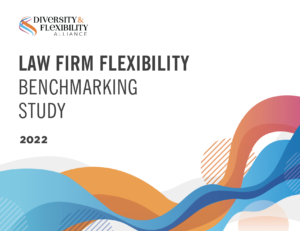 The 6th Law Firm Flexibility Benchmarking Study is now available for members and non-member law firms who participated in the survey.
The 6th Law Firm Flexibility Benchmarking Study is now available for members and non-member law firms who participated in the survey.
This year’s Study consists of responses from 68 major law firms and examines the availability and accessibility of hybrid work, holistic flexible work, and parental leave.
The 2022 Law Firm Flexibility Benchmarking Study is available to members and non-member participants. Members can access the report in the Member Resource Center.
Further, members can access a recording of the 2022 Flexibility Benchmarking Summit in the Member Resource Center. This event shared trends and best practices in workplace flexibility, hybrid and leave policies implemented at law firms, and the types of support available for those who work flexibly. The Summit included valuable discussions between Manar Morales, Alliance President & CEO, and leaders from firms with innovative policies and practices in the areas of workplace flexibility and caregiver leave:
- Zakiyyah Salim-Williams, Partner & Chief Diversity Officer, Gibson Dunn
- Don Smith, Chief Talent & Inclusion Officer, Crowell & Moring
Please contact Sejal Shah with any questions about this research study.
